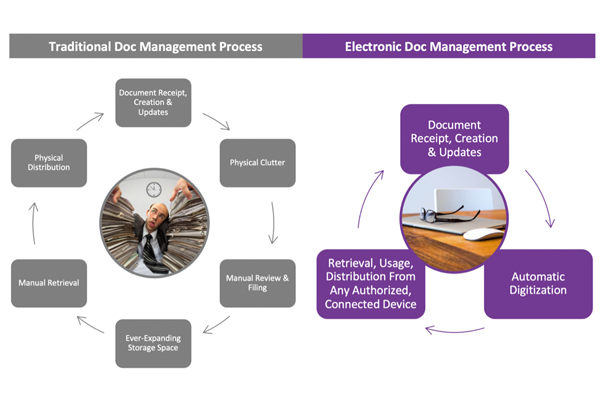 Is electronic records management truly more cost-effective than its analog alternatives? That’s an argument we’ve made before, and it’s one that’s substantial enough that it’s worth unpacking further. A white paper from the Federal Records Management Council (FRMC) on the cost benefits of digitization details the myriad areas of potential cost savings, writing that even just the costs of failures associated with analog and paper-based records management can often “far exceed initial investments to safeguard records through a modern digitization strategy.”
Is electronic records management truly more cost-effective than its analog alternatives? That’s an argument we’ve made before, and it’s one that’s substantial enough that it’s worth unpacking further. A white paper from the Federal Records Management Council (FRMC) on the cost benefits of digitization details the myriad areas of potential cost savings, writing that even just the costs of failures associated with analog and paper-based records management can often “far exceed initial investments to safeguard records through a modern digitization strategy.”
But what are those areas where electronic records management eclipses analog? Another white paper from consultancy group Deloitte looks at the records management lifecycle and divides it into five major categories, each of which accumulates often significant cost savings.
1: Origination
Records creation alone can be intensely time-consuming and costly, often involving more than just filling out forms. The time and effort required for gathering, exchanging, and verifying information can add up quickly. According to Deloitte, this stage alone can account for over a third of the costs associated with records managing and handling, which means that electronic document handling can help to reduce costs right away.
While the basic records management processes may not vary greatly between analog and electronic at this stage, the automation inherent in an electronic records management solution can reduce overall workload. If nothing else, using a “template” with pre-filled data will make it easier and faster to create new records.
2: Transport & Processing
At this stage of records management, electronic systems really begin to shine. Handling analog records incurs transportation and handling expenses – again, as much as 30% or more of total records management costs, per Deloitte. These expenses largely disappear with an electronic solution, with which transferring records from Point A to Point B is seamless and usually instantaneous.
3: Storage & Retention
Storage costs don’t disappear with an electronic solution, but keeping documents as digital bits is a far cry from having to find ongoing physical space for their paper equivalent. For one federal agency that adopted the TransAccess DM system, creating a single-source repository for electronic records reduced records costs by 70% because they were able to store, manage, update, and secure records at one point instead of across many disparate applications.
The FRMA paper explains the mechanism of these savings: “Real estate savings gained from eliminating physical storage space can be sizable and realized relatively quickly. Agencies can recoup dollars spent leasing and maintaining real estate, or repurpose the space and resources for higher value activities.”
4: Retrieval
When physical records are needed for future reference or usage, it sets into motion an often lengthy, laborious, and expensive process of (1) finding the recording, (2) physically retrieving the record, (3) transporting the record to wherever it’s needed for additional processing, and finally (4) returning the record to storage. Research shows that workers can spend as much as 19% to 30% of their workday just searching for information.
 Not only is this process often slow and expensive, but the effort also increases risks of the record being lost because it increases the number of points at which the records can be lost. As with transport and processing, electronic records management collapses this entire process into a simple and immediate experience (see the illustration below).
Not only is this process often slow and expensive, but the effort also increases risks of the record being lost because it increases the number of points at which the records can be lost. As with transport and processing, electronic records management collapses this entire process into a simple and immediate experience (see the illustration below).
5: Destruction
To avoid ever-creeping storage costs, many records are scheduled for destruction at specific intervals set by the organization’s records schedule. This is not cost-less, particularly for confidential records that require more than just a simple delete function. Indeed, an electronic solution can often auto-delete (including “secure” delete functionality that overwrites the data file) with no manual intervention required.
Ultimately, even when the principal steps in the records management process go unchanged (e.g., the electronic solution is simply set up to accommodate existing processes), it will nevertheless result in faster turnaround, lowered transportation costs, and significantly less overall manual labor – often eliminating manual steps altogether. That’s one of the best cost advantages of the system: electronic solutions simply collapse labor-intensive management processes into automated, streamlined ones.
About PSL
PSL is a global outsource provider whose mission is to provide solutions that facilitate the movement of business-critical information between and among government agencies, business enterprises, and their partners. For more information, please visit or email info@penielsolutions.com.

